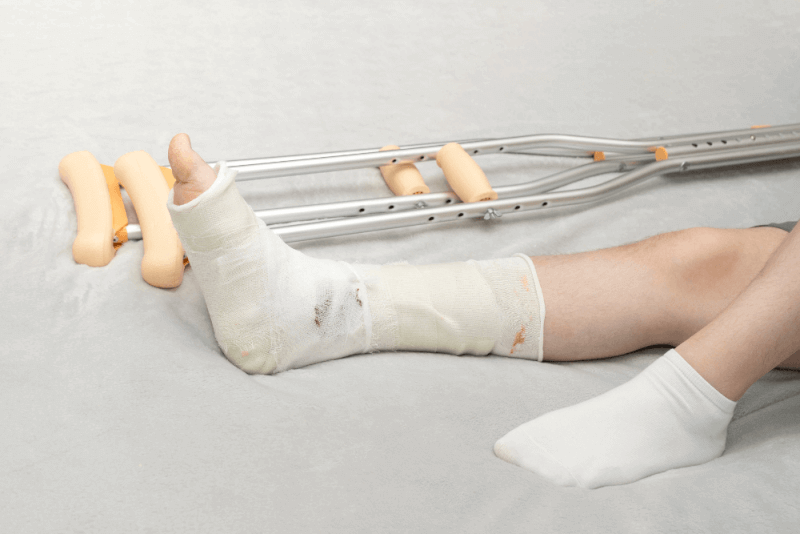30 Second Summary
- An ankle fracture is a fracture that occurs in any of the bones that make up the ankle.
- It can occur as a result of traumatic events such as bumps and traffic accidents.
- Symptoms include pain, swelling, bruising and restricted movement of the ankle.
- Treatment depends on the degree and condition of the fracture. Mild ankle fractures can be treated with a cast or splint. Moderate and severe ankle fractures may require surgery.
What is an ankle fracture?
Ankle fractures are fractures of the bones called fibula, tibia or talus. Ankle fractures, which can occur at any age, usually occur as a result of impact, trauma or fall. However, ankle fractures are a health problem especially in athletes, as more falls and trauma are seen in people who do sports.
Fractures in any of the three bones that make up the ankle cause severe pain due to the highly mobile nature of the area. In addition to pain, edema is also observed. These complaints can sometimes be confused with ligament and tissue injuries. For this reason, it is important to consult a physician immediately if an ankle fracture is suspected.
Causes of ankle fracture
An ankle fracture is caused by severe trauma to the ankle. Trauma can be caused by falls, accidents, collisions and sprains. A doctor should be consulted in severe foot sprains, as the sprain of the ankle will cause the fracture to be hidden.
How to break the ankle?
There are 3 different bones in the ankle. The outer one of these bones is called the fibula and has a bone protrusion called the lateral malleolus at the very end. On the inside, there is a bone called medial malleolus. Between these two bones is the tibia, also known as the shin bone. A significant proportion of ankle fractures occur in the bone called the tibia.
How is an ankle fracture diagnosed?
The symptoms of ankle fractures are similar to those of tendon or connective tissue injuries. This can lead to confusion during diagnosis. X-rays are absolutely necessary to prevent this situation. If necessary, 3D imaging of the ankle joint and the condition of the soft tissues around the joint should also be determined. For this, patients may be asked for CT or MRI images.
If an ankle fracture is suspected, a doctor should be consulted as soon as possible. During this time, the ankle joint is immobilized and cold compresses are applied. must be done.
Ankle fracture symptoms
In the event of an ankle fracture, patients first feel severe pain. In addition, the symptoms of ankle fractures include the following.
- Some patients may hear a cracking sound coming from the foot bone with the sprain
- The movement of the ankle is completely restricted
- Patients cannot get power from the fractured wrist
- In fractures of the lateral malleolus, patients can step on their feet, although it is difficult.
- The pain may occur at the moment of impact or a few hours after the impact.
- Swelling and bruising are seen in the ankle area.
- Depending on the severity of the impact on the ankle, tendons or tissues in the ankle may be damaged. In this case, patients feel much more severe pain.
Life after ankle fracture
There are some points that patients should pay attention to for faster healing of ankle fractures. The most important of these is a healthy and balanced diet. After that, there are the following points that patients should pay attention to after ankle furrow:
Ensuring adequate blood circulation
Bones are one of the few organs in the body that can repair themselves. For this to happen, many different actors need to come together. These include nutrients, amino acids, hormones, cells that break down and rebuild bone, antioxidants and growth factors. In order for these to reach the broken bone tissue, it is important to ensure adequate and healthy blood circulation.
Bruising at the fracture site
Bruising after ankle fractures is a sign of healing. This is because the bruise is caused by the accumulation of cells that repair the fracture. In addition, signaling molecules are released that enable communication to repair bone cells. The healing process produces cells that produce bone and cartilage. Afterwards, cells are formed that clean the bone waste in the area.
Bone reconstruction
The second stage of ankle fractures is the reconstruction of bone tissue. In this phase, which begins approximately 2 weeks after the fracture, the soft callus, which is responsible for fixing the bone, is formed. Between 6 and 12 weeks, this structure hardens and becomes able to bear weight.
Smoking negatively affects bone repair
Smoking negatively affects the healing process of fractures as it negatively affects blood circulation. For this reason, smoking should be avoided to shorten the healing process of fractures.
Trotter soup
Patients should pay attention to their nutrition for faster healing of fractures. Because the process of bone repair requires a lot of energy. For example, the daily caloric requirement of a healthy individual is 2500 calories, while the amount of calories required for fracture healing is 6000 calories. Collagen is one of the most important nutrients in this repair process. Because collagen is of great importance in rebuilding the bone structure. In addition, increasing protein intake also helps bones to heal faster. For this reason, trotter soup provides an advantage to patients.
Consumption of milk and dairy products
For ankle fractures to heal faster, patients need to take more calcium. However, calcium intake alone is not enough. Vitamin D should also be adequate. Because vitamin D is necessary for calcium to be absorbed from the intestines and bound to bone tissue.
Ankle fracture treatment
In order to treat the ankle, physicians pay attention to the following points:
- Whether there are ligament or tendon problems accompanying the fracture
- Impact on the joint surface
- Amount of fracture separation
Considering these criteria, the most appropriate treatment method is determined. There are two different treatment methods for ankle fractures. The first of these is plaster casts and the other is surgical applications.
Ankle fracture surgery
If the bones are too far apart due to an ankle fracture or if there are deformities in the ankle, then surgery may be required for treatment. During surgery for ankle fractures, the broken and separated bones are surgically replaced. Plates, screws or wires are then used to stabilize the bone. In this way, the broken bone is fixed in the correct position and the bone is allowed to fuse.
If there is a rupture of connective tissues as well as an ankle fracture, this condition is also intervened during the surgical operation. For this, pieces with stitches at the end, called chords, are used.
Ankle fracture surgeries are usually performed arthroscopically. This method, also called closed surgery, allows patients to recover faster. It is normal for patients to experience severe pain after ankle surgery. However, this condition can be controlled with medication. During this time, patients remain under observation at the hospital. It takes a few weeks for patients to return to their normal lives after surgery.
Summary of Surgery
Duration of Surgery 1-3 hours
Anesthesia Method: General, Spinal, Epidural anesthesia
Length of Hospitalization: 1-3 days
Return to Work Time: 6-8 Weeks
Plaster cast in ankle treatment
The most common method used for ankle fractures is plaster casts. However, the broken bones must not be too far apart for the plaster to be applied. In some patients, medical equipment called cast boots, which can be worn and removed, can also be used instead of a cast.
When does an ankle fracture heal?
The timing of the treatment of an ankle fracture depends on many different factors. These factors include the age of the patient, the condition of the fracture, the gender of the patient, and the condition of the ligaments and tendons.
Regardless of the type of ankle treatment, the rehabilitation process after treatment is of great importance. This is because the movements performed during the rehabilitation period ensure faster healing of fractures and tissue damage. In general, ankle fractures heal within 2 to 3 months after casting and within 4 to 5 months after surgery.
Factors that have an impact on the healing of the ankle are the following.
- Deficiency of vitamins important for cartilage and bone health,
- Infections in the body
- Autoimmune diseases
- Metabolic disorders
- Cigarette smoking
- The fracture affects the inside of the joint
- High fragmentation in the fracture
Edema after ankle fracture
After ankle fractures, both the effect of trauma and prolonged immobilization of the foot cause edema formation. Edema due to lazy veins increases especially when standing for long periods of time. In order to prevent this, applications such as limiting standing times, keeping the foot elevated while sitting or lying down and cold compress applications are used. After healing of the ankle fracture, bandages are also used to disperse the edema.
Arthritis after ankle fracture
There are 3 main causes of calcification in the ankle. These causes are arthrosis, rheumatoid arthritis and ankle fractures. Fractures that occur after traumatic events cause disruption of the ankle joint structure. This situation prepares the ground for the emergence of calcification problem.
Calcification that may occur after an ankle fracture also needs to be treated. The treatment method to be applied varies according to the age of the patient, the rate of calcification and the bone structure. If arthritis is in the early stages, regular exercise prescribed by the doctor as well as pain medication is beneficial. In addition, physical therapy will provide relief of the calcified joint.
In addition, arthroscopic debridement method can also be applied in the treatment of early stage joint calcification. This method is popularly known as joint cleaning. Because with this method, the calcified tissues in the joint are cleaned. However, ankle prosthesis is performed in ankles that are severely deformed due to calcification.










